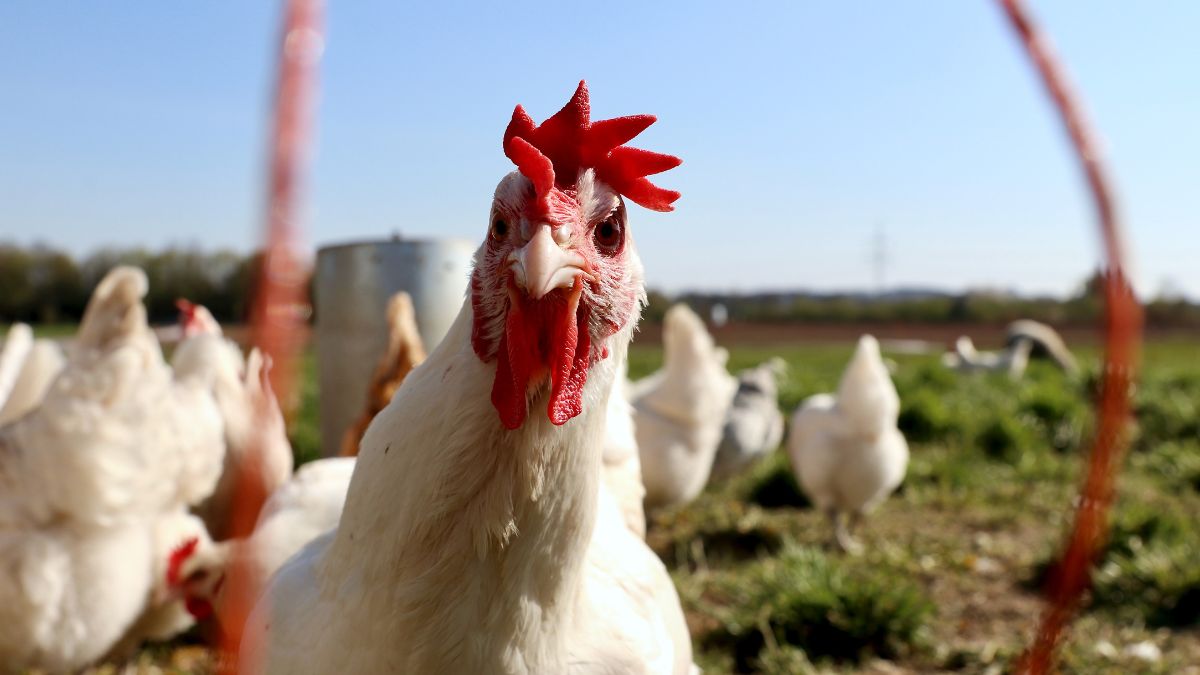Can Chicken Eat Celery? Is It Safe for Them?

When it comes to feeding chickens, it’s important to know what foods are safe for them to eat. Celery is a common vegetable that many people have in their kitchens, but is it safe for chickens to eat?
In this article, we will explore the topic of whether or not chickens can eat celery and if it is safe for them. So, let’s dive in!
The Nutritional Composition of Celery
Celery is a low-calorie vegetable that’s packed with essential vitamins and minerals. While it’s mainly comprised of water (around 95%), it offers a range of nutrients that can contribute to a balanced diet.
Apart from being a hydrating food source, celery is also rich in dietary fiber, which aids in digestion. It’s a good source of Vitamin K, and also contains moderate amounts of Vitamin A, Vitamin C, and some essential minerals.
These nutrients can potentially play a role in the overall health of chickens, just as they do for humans.
Nutritional Table for Celery (per 100g)
| Nutrient | Amount |
|---|---|
| Calories | 16 |
| Water Content | 95% |
| Protein | 0.7 g |
| Total Fat | 0.2 g |
| Dietary Fiber | 1.6 g |
| Vitamin K | 29.3 mcg |
| Vitamin A | 449 IU |
| Vitamin C | 3.1 mg |
| Folate | 36 mcg |
| Potassium | 260 mg |
| Calcium | 40 mg |
| Magnesium | 11 mg |
Please note that the table provides approximate values for the nutritional composition of celery. The exact values can vary based on factors such as the variety of celery, soil conditions, and cultivation methods.
Potential Benefits of Celery for Chickens
While the primary diet of chickens consists of grains, seeds, and protein sources, introducing vegetables like celery can offer various benefits. Here’s how celery might benefit your poultry:
Hydration Boost: Given that celery is made up of about 95% water, it can serve as an additional hydration source, especially during hotter days. Hydration is crucial for chickens to maintain their body temperature and ensure proper digestion.
Dietary Fiber: The fiber content in celery aids in digestion. For chickens, it can help ensure a smooth functioning digestive system, potentially reducing the risk of issues like impacted crop.
Vitamin Source: The vitamins present in celery, particularly Vitamins A, C, and K, can support the overall health of chickens. Vitamin A is essential for vision, bone growth, and reproduction. Vitamin C can aid in stress reduction and boost immunity, while Vitamin K plays a role in blood clotting.
Mineral Intake: Minerals like potassium, calcium, and magnesium found in celery can support various bodily functions in chickens. Calcium, for instance, is vital for laying hens as it aids in the formation of strong eggshells.
Low-Calorie Treat: Since celery is low in calories, it doesn’t contribute to excessive weight gain. This makes it an excellent treat option for chickens without significantly altering their regular dietary intake.
Natural Behavior Stimulation: Offering fresh vegetables, including celery, allows chickens to engage in natural behaviors like pecking and foraging. This can serve as a form of enrichment, potentially reducing boredom and related behavioral issues.
Antioxidant Properties: Celery contains antioxidants that can help fight off free radicals in the body. While more research is required, these antioxidants could potentially contribute to the overall health and longevity of chickens.
While celery can offer various benefits, it should be introduced gradually and observed for any adverse reactions. Always ensure that treats and supplementary foods, like celery, make up only a small portion of a chicken’s diet.
Any Risks Associated with Feeding Celery to Chickens
While celery is generally safe for chickens, as with any food introduced into their diet, there are potential risks to consider. Here’s a breakdown of possible concerns when feeding celery to your flock:
Choking Hazard: One of the primary risks with feeding celery to chickens is the stringy nature of the vegetable. If not chopped into smaller, manageable pieces, these strings can pose a choking hazard or cause an obstruction in their digestive system.
Digestive Issues: If chickens consume a large amount of celery in a short time, especially if they’re not used to it, they could experience digestive disturbances. It’s always best to introduce any new food, including celery, gradually.
Pesticide Residue: Non-organic celery may contain pesticide residues that can be harmful to chickens. If you decide to feed celery, it’s advisable to opt for organic varieties or ensure the vegetable is thoroughly washed before offering it to your birds.
Nutritional Imbalance: While celery is nutritious, it shouldn’t make up a significant portion of a chicken’s diet. Overfeeding any single vegetable can lead to an imbalance in the nutrients a chicken receives. Their primary diet of pellets or grains should always be the dominant food source.
Possible Allergic Reactions: Though rare, like all creatures, chickens can have unique sensitivities or allergies. Always monitor your chickens when introducing any new food to ensure there are no adverse reactions.
Overhydration: Given celery’s high water content, excessive consumption could potentially lead to overhydration. However, this is a rare occurrence and would require a substantial amount of celery in a short period.
To mitigate these risks, always ensure that celery is given in moderation, appropriately prepared, and introduced gradually. Observing your flock after introducing new foods can help identify any potential issues early on.
Preparing Celery for Your Chickens: Best Practices
When it comes to feeding your chickens celery, the manner in which it’s prepared can make all the difference. Proper preparation ensures that your birds can enjoy the treat safely and derive maximum benefits from it. Here are some best practices to follow:
- Wash Thoroughly: Start by washing the celery to remove any dirt, bacteria, or pesticide residues. If possible, use organic celery, as it is less likely to contain harmful chemicals.
- Chop into Manageable Pieces: To prevent choking, chop the celery into smaller, bite-sized pieces. This makes it easier for the chickens to peck at and consume. Remember to especially watch out for the stringy parts of the celery, as these can pose a choking hazard.
- Mix with Other Treats: Combining chopped celery with other chicken-safe vegetables or grains can make it a more enticing treat for your flock. It also ensures they get a mix of nutrients.
- Avoid Overfeeding: Remember that treats, including celery, should be supplementary. The primary diet of chickens should be a balanced poultry feed. Offer celery in moderation to prevent nutritional imbalances.
- Fresh is Best: Always offer fresh celery. Avoid giving wilted, moldy, or discolored celery as it may harbor harmful pathogens or toxins. Ensure that leftover celery bits are cleared from the coop to prevent mold growth.
- Gradual Introduction: When introducing celery (or any new food) to your chickens, do so gradually. This allows you to monitor them for any potential allergic or adverse reactions.
- Observe After Feeding: After giving your chickens celery, watch their behavior and droppings for a day or two. This helps in ensuring they aren’t facing any digestive issues or other health problems due to the new addition to their diet.
- Storage: If you have leftover celery that you intend to give to your chickens later, store it in the refrigerator to keep it fresh. Before feeding, ensure it’s free from any mold or foul smell.
Incorporating these best practices can ensure that your chickens safely enjoy celery as a healthy treat, adding variety and nutrition to their diet.
Other Vegetables That Are Safe for Chickens
Chickens are omnivores with a diverse palate, and many vegetables are both safe and beneficial for them. Incorporating a variety of vegetables can provide additional nutrients, enhance their overall diet, and stimulate their foraging behavior. Here are some other vegetables that are safe for chickens:
- Leafy Greens: Lettuce, spinach, kale, Swiss chard, and other leafy greens are excellent for chickens. They’re packed with vitamins and minerals and can be scattered around the coop for foraging.
- Cucumbers: A great hydration source, cucumbers can be a refreshing treat, especially during warmer months.
- Carrots: Whether served raw, cooked, or in the form of carrot tops, carrots are a hit with most chickens.
- Broccoli: This can be given both raw or lightly steamed. The head of the broccoli is often enjoyed, but don’t forget the leaves and stalks – chickens love them too!
- Peas: Fresh or frozen peas are a nutritious treat. They can be sprinkled around the coop or garden for the chickens to find.
- Sweet Potatoes: While raw potatoes (especially green parts) are not recommended for chickens due to solanine content, cooked sweet potatoes are safe and nutritious.
- Pumpkin: Beyond the flesh, even pumpkin seeds are beneficial as they can act as a natural wormer.
- Bell Peppers: Remove the seeds and offer the crunchy flesh to your chickens. They are packed with vitamins and can be a colorful addition to their diet.
- Zucchini and Squash: Both are safe for chickens and can be given raw.
- Green Beans: It’s better to cook or steam green beans before offering them to chickens, as raw beans can contain harmful substances.
- Cabbage: A whole cabbage can be hung in the coop, providing both nutrition and entertainment as chickens peck at it.
It’s crucial to introduce any new food gradually and observe your chickens for any adverse reactions. Always ensure the vegetables are fresh and free from harmful chemicals or pesticides.
To Feed or Not to Feed: Concluding Thoughts on Celery for Chickens
Chickens, with their diverse dietary preferences, have a knack for turning many kitchen scraps into valuable eggs and entertainment for those who rear them. Celery, a vegetable commonly found in our kitchens, presents itself as a viable treat option for these birds.
Rich in vitamins, minerals, and water content, celery can offer hydration, especially on warmer days, and a splash of nutrition outside their regular feed. Moreover, the fibrous content promotes digestive health, which is crucial for a chicken’s overall well-being.
However, as with any treat or supplementary food, moderation is key. While celery itself is not harmful, the manner of its introduction and the quantity matters. The stringy nature of celery calls for careful preparation to avoid potential choking hazards. Plus, over-relying on any one treat can inadvertently offset a chicken’s balanced diet.
In the broader spectrum of poultry care, it’s also crucial to be mindful of the source of the vegetables we offer. Pesticide residues, often present in non-organic produce, can have detrimental effects on a chicken’s health. Hence, a thorough wash, or better yet, sourcing organic celery, can be a more cautious approach.
In conclusion, while the primary diet of chickens should remain a high-quality poultry feed, introducing treats like celery can be both beneficial and enjoyable for them. As always, keen observation and understanding individual flock needs will guide any chicken keeper in making the right dietary choices for their birds.

